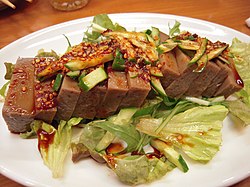Acorn

The acorn is the fruit of the oak tree.[1] It is a nut, and has a single seed (rarely two seeds), enclosed in a tough, leathery shell. Acorns vary from 1 – 6 cm long and 0.8 – 4 cm broad. Acorns take between about 6 or 24 months (depending on the species) to mature.
Acorns are one of the most important wildlife foods in areas where oaks grow.[2] Creatures that make acorns an important part of their diet include birds, such as jays, pigeons, some ducks, and several species of woodpeckers. Small mammals that feed on acorns include mice, squirrels, and several other rodents. Such large mammals as pigs, bears, and deer also eat large amounts of acorns: they may constitute up to 25% of the diet of deer in the autumn.[3] In some of the large oak forests in southwest Europe, traditionally called "dehesas", pigs are still turned loose in oak groves in the autumn, to fill and fatten themselves on acorns.
Acorns contain tannins, which are toxic to some animals such as horses. The tannins can be soaked out, using water.
Acorn Media
Acorns of the willow oak in South Carolina (from small to large, counterclockwise from center): Q. phellos (willow oak), Q. falcata (southern red oak; top right), Q. alba (white oak), and Q. coccinea (scarlet oak). Scale bar at upper right is 1 cm.
Sprouting acorn of Quercus robur
Dotori-muk, a Korean dish made with acorn starch
Campaign hat worn by General Sherman
Mortar holes for pounding acorns into flour, Lost Lake, California
Chuckachancy women pause in their work preparing acorns for grinding, California, c. 1920
References
- ↑ (genera Quercus, Lithocarpus and Cyclobalanopsis, in the family Fagaceae)
- ↑ Janzen, Daniel H. 1971 Seed predation by animals. In Richard F. Johnson, Peter W. Frank and Charles Michner (eds) Annual Review of Ecology and Systematics.
- ↑ Brown, Leland R. 1979. Insects feeding on California oak trees. In Timothy Plum and Norman Pillsbury (eds) Proceedings of the Symposium on Multiple-use management of California's hardwood resources, Gen. Tech. Rep. PSW-44, USDA, Forest Service, Pac. S.W. Forest and Range Experiment Station, Berkeley, California, pp. 184–194.









